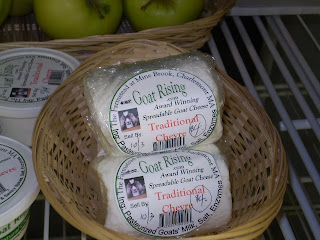 Celeriac is not the prettiest of vegetables. It's brown, covered in hair-like fibers, and looks a little bit deformed. But its mild celery flavor and creamy texture are two reasons why professional chefs are utilizing it in soups, purées, salads and many other dishes.
Celeriac is not the prettiest of vegetables. It's brown, covered in hair-like fibers, and looks a little bit deformed. But its mild celery flavor and creamy texture are two reasons why professional chefs are utilizing it in soups, purées, salads and many other dishes.Celeriac is just one of the many vegetables grown by husband and wife, Timothy N. Wilcox, 28, and Caroline C. Pam, 32, owners of The Kitchen Garden in Sunderland, Mass. They started their careers as long-time foodies from New York. After farming on rented land for two years, the couple decided to buy their own piece of land, a seven-acre stretch of lush river bottom soil that today they call The Kitchen Garden. Now, two years later, they provide local chefs, like Paul C. Hathaway, 41, executive chef at Chez Albert in Amherst, Mass., with many of their products.
 Pam, who studied French cuisine at the French Culinary Institute in New York Ciy, and Wilcox, who studied Social Science and Italian at Hampshire College in Amherst, are now growing the food that they'd expect from a gourmet restaurant. "We grow food because we love to eat food and we love to cook food," said Pam.
Pam, who studied French cuisine at the French Culinary Institute in New York Ciy, and Wilcox, who studied Social Science and Italian at Hampshire College in Amherst, are now growing the food that they'd expect from a gourmet restaurant. "We grow food because we love to eat food and we love to cook food," said Pam. Wilcox worked with radicchio farmers in Treviso, Italy for his graduation thesis and Pam spent a summer in Italy working on an organic farm before they opened The Kitchen Garden together. They stress the importance of quality products, noting that if an ingredient tastes good right from the ground, it will taste even better on the plate. This philosophy has helped the couple develop close relationships with many local chefs.
Hathaway has been working with Wilcox and Pam for three years. "The quality of their ingredients, the care they take, and the fact that they like to do unique items," Hathaway said, keeps him coming back for more.



Chez Albert is not a traditional farm-to-table restaurant, but one that believes in using nothing but the best. This sets it apart from the other farm-to-table eateries. "I believe in that philosophy, but I don't use the products just because they're local. I use them because they're good," Hathaway explained. "If the local products weren't very good, I wouldn't use them."
The farmers agree. "Working with the restaurants is a natural fit for us," Pam said. "They know what they want and they appreciate food as much as we do."
Hathaway, who once worked with Pam at Green Street Cafe in Northampton, Mass., says that forming relationships with the farmers is, "a fantastic and interesting journey."


In fact, it's much like the journey celeriac makes on its way from farm to table. It starts as a tiny seed and grows into an oddly shaped bulb. When mature, celeriac, also known as celery root, has a "mild celery flavor with the creaminess of potato and hints of sweetness," Hathaway said. It's adaptable and matches perfectly with many other ingredients.
Chef Paul Hathaway's Kitchen Garden Celeriac Purée Recipe
1 ½ peeled celeriac (about 2 unpeeled)
6 oz crème fraîche or plain yogurt
salt and pepper
Boil celeriac in lightly salted water until a knife can run through it.
Then strain, place in a blender and purée with crème fraîche.
Once silky smooth, season with salt and pepper to taste and serve.
Great served with roast chicken, fish, meat or even roasted mushrooms and and vegetables.
1 ½ peeled celeriac (about 2 unpeeled)
6 oz crème fraîche or plain yogurt
salt and pepper
Boil celeriac in lightly salted water until a knife can run through it.
Then strain, place in a blender and purée with crème fraîche.
Once silky smooth, season with salt and pepper to taste and serve.
Great served with roast chicken, fish, meat or even roasted mushrooms and and vegetables.














